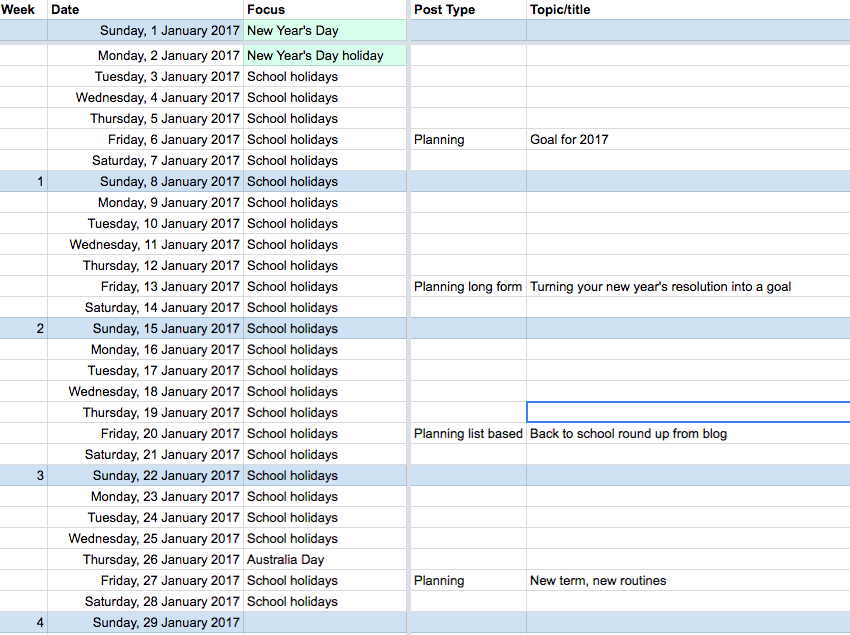This is a guest contribution from ProBlogger Expert Nicole Avery.
Creating a blog content plan is one of the best things you can do to ensure your blog has quality content that is created efficiently with the time you have available.
A common cry I hear from bloggers who don’t use a content plan is that if they planned out their content it would stifle their creativity. I like to challenge that premise and argue that creating a blog content plan allows you to have more creative freedom.
Having a content plan means that when you sit in front of your screen to write your post, you have an idea or topic to write about that:
a). you have had time to ponder and meditate on in advance making the writing come easier
b). you can disregard because you have something else that interests you more to write about.
But if you don’t have a plan and you have limited time to blog, you can often find yourself sitting in front of the dreaded blank screen with no idea what to write about. Plans can be changed, but only if you have a plan to change in the first place.
Where to get ideas for blog posts
The first stage of creating a blog content plan is idea generation. Most bloggers will have ideas for posts floating around somewhere. It is time to gather them all together in the one place.
I use a simple Google sheet as my master planning tool for my blog. I allocate one tab to be the home for all my blog post ideas. Being in a Google sheet means I can access it from any device and add ideas on the go if I become inspired.
Before scheduling out ideas in your blog content plan, brainstorm as many ideas as you can and list them in your sheet. If you need help finding ideas try these strategies:
Survey your readers
Each year I survey my readers on the blog. This process is to not only receive feedback on how they have found the content I have published over the preceding year, but to also tap into what their key issues are currently and what questions they have for me.
Make sure you have specific questions in the survey to elicit blog post ideas and topics. Simply asking them “what do you want me to write about”, may not generate many ideas, but asking them something specific for example like “What is your biggest distraction when it comes to working online?” however would generate many topics for you to write about if you are in the productivity or working online space. For every distraction your readers share, you could create a post that helps them solve this problem.
Use reader questions
Through out the year readers may have asked you questions via email or Facebook. Even if you have responded to them on those mediums, those answers you have written may be applicable to your broader audience and could be turned into a blog post.
Use magazines for inspiration
Depending on your niche, you maybe able to look at magazines for inspiration for blog post topics. For example if you are blogging in the gardening niche, for the first two months of 2017 (which is summer for us in the Southern Hemisphere), check out summer editions of gardening magazines to see what topics they cover. You can write your own take on some of these seasonal ideas.
Think about having a theme for the year
Each year on my blog I have a theme overarching the content through out the year. Not every post will relate to the theme, but around one a month will and I will have a series on the theme as well.
A theme can allow you to explore topics in a deep and informative manner or entertain readers through a connected narrative.
How to create your blog content plan
So now you have a sheet full of amazing blog post ideas, it is time to create your blog content plan. Here are your next steps:
Determine posting frequency
How frequently you post will differ for every blogger. My personal philosophy on frequency is that quality always trumps quantity, so if you are new to blogging I would start conservatively and build up, rather than find yourself running out of steam and publishing “filler” posts.
In the example below you will note that there is only one post per week. I take holidays in January from the blog, so schedule out only one post a week. Once I return in February I will resume to posting three times a week, so adjust your posting frequency to take into account when you will have holidays from the blog if needed.
Create planning sheet
Once you know your frequency, create another tab in your planning spreadsheet like the one below. It has columns for:
- Week – so you can keep track of how many weeks into the year we are
- Date – so you know when to post!
- Focus – if there is something going on at that particular time that you need to be aware of like school holidays, course launches etc
- Post type – I write a mix of post types on my blog, some will be list style posts, some will be recipes, some will be long form, some will be about planning, some will be about parenting for example. Noting this allows me to offer up a mix of content across the week, months and year.
- Topic/title – sometimes I will know the exact title for a post, other times I will know the topic like “goal setting for 2017” and the title will come after I have written it.
Add in seasonal posts
The first posts I add to the plan are seasonal posts. Posts like:
- New year’s posts
- School holiday posts
- Easter posts
- Halloween posts etc
The beauty of having these posts planned out means you can have them published in the lead up to the event, making them relevant and timely for your readers and also hopefully relevant to the search engines!
Add in regular posts
If you post regularly on particular topics, schedule those in next. For example, I write a monthly review the first Friday of every month, so I will note that topic down. As I won’t know how the month turned out compared to my goal, I have the general topic “monthly review” only and fill the rest in as it comes closer to the date.
Add in any series you want to create
If you know you want to write a series through out the year, allocate it to the days you want to publish the posts that will be part of the series.
Add in sponsor work if known
If you are a blogger who works with brands and know some of the brand related commitments you have through out 2017, add those into your plan as well.
Add in product launch posts
Many bloggers have products now that they sell from their blogs and which require product launches. Schedule in any known launches you have planned for 2017 and if you are in the process of creating a product, give yourself a deadline and schedule in the launch posts.
Add in key personal dates
If you share personal stories on your blog, then factor in those events to the relevant dates. For example if you have holidays planned in July and November and you will write about them on your blog, schedule them in for August and December.
Add in key business events
If you have a bricks and mortar business or an online business, schedule in any posts that will relate to key events in that will happen in 2017. This might be events like the Black Friday sales, end of financial year sales etc.
Add in any theme posts
If you chosen to have a theme on your blog for 2017, add in posts on your theme next.
Add in reader input
Add in the post ideas that have come from your reader’s questions and your reader survey.
Add in posts missed from last year
If you had a blog content plan from last year, add in any posts you may have missed writing in 2016 to the plan for 2017.
By the time you have reached this far, you will hopefully have a full content plan for 2017! This will be a creative guide for you to use as a base to make the blog writing process as efficient and as easy as possible.
Do you create a content plan for your blog each year?
Nicole Avery is a Melbourne mum to five beautiful kids aged seven to 17. She is the master organiser behind the popular parenting blog Planning With Kids and the author of a book by the same name, where she shares tips and tricks for organising the chaos of family life. She is slightly addicted to spreadsheets, tea, running and, of course, planning!
The post Creating a Blog Content Plan for 2017 appeared first on ProBlogger.


No comments:
Post a Comment